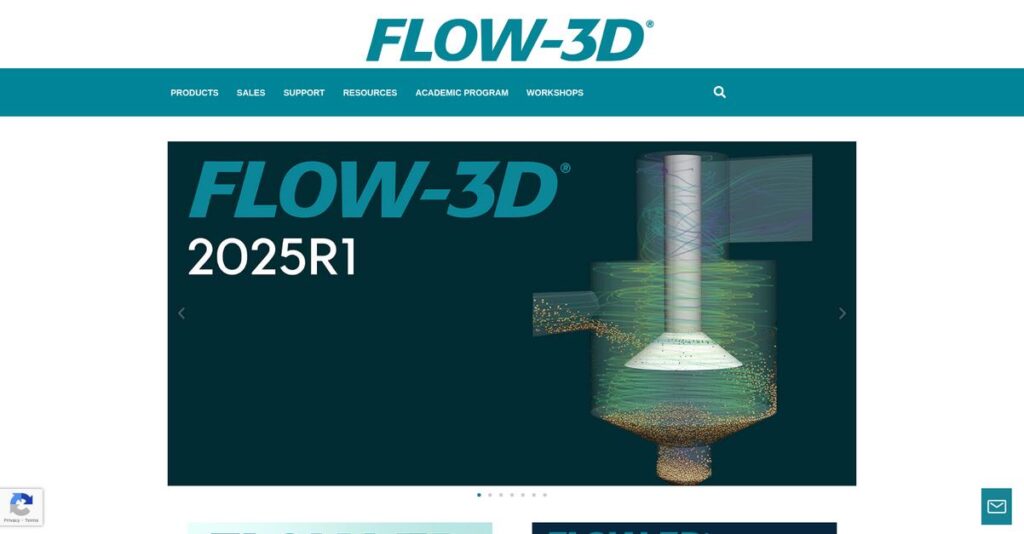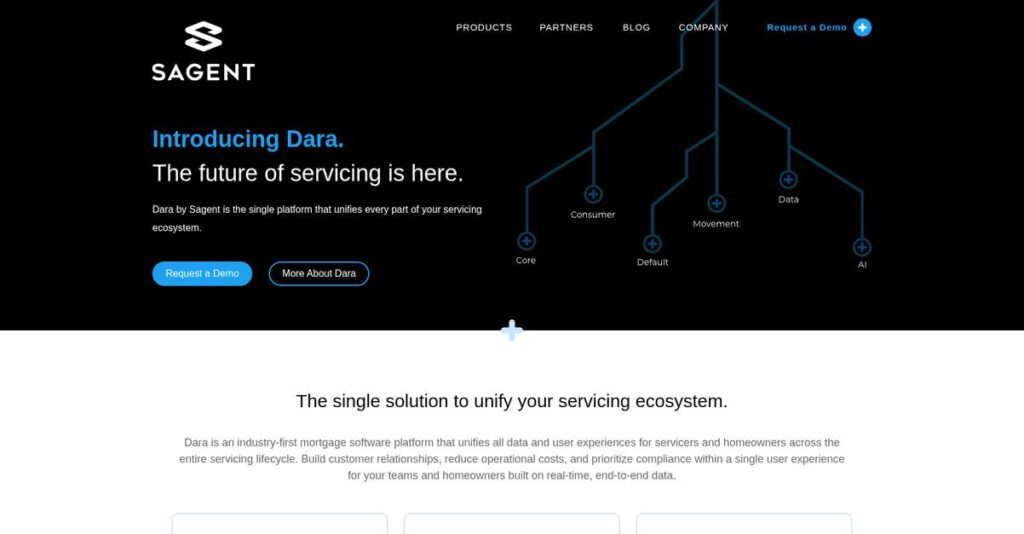Struggling with complex fluid modeling accuracy?
If you’re frustrated with unreliable CFD results or painful mesh setup, you’re probably looking for something that just works—especially for free-surface and multiphysics problems.
The reality? Bad simulation accuracy keeps you re-running test after test, wasting your engineering hours and holding up every stage of product design.
That’s why I spent time digging into how FLOW-3D solves the grid headaches, free-surface instability, and workflow bottlenecks so many engineers encounter—plus how their TruVOF method and workflow automation genuinely set them apart.
In this review, I’ll show you how FLOW-3D can accelerate and simplify simulation work in the day-to-day projects that matter most.
You’ll find a detailed FLOW-3D review of features, core strengths, pricing, ease of use, and how it actually performs versus rivals like Ansys Fluent, COMSOL, and OpenFOAM—so you can make the right call for your workflow.
If you want clear answers about the features you need to cut simulation time and headaches, you’re in the right place.
Let’s dive into the analysis.
Quick Summary
- FLOW-3D is a specialized CFD software that simulates complex fluid flows with precise free-surface and multiphase modeling.
- Best for engineers and researchers requiring detailed analysis of fluid dynamics in civil, manufacturing, and aerospace fields.
- You’ll appreciate its accurate TruVOF method and strong customer support that help tackle challenging fluid problems efficiently.
- FLOW-3D offers custom pricing upon request, with academic discounts and limited free trial periods available.
FLOW-3D Overview
The company behind FLOW-3D, Flow Science, has been around since 1980. Based out of Santa Fe, New Mexico, they were founded by Dr. C.W. Hirt, a true CFD pioneer.
They work across industries like civil engineering, manufacturing, and aerospace. However, what sets them apart is a laser-focus on free-surface problems. This isn’t a generic, all-in-one tool; it’s a specialist solution.
The recent launch of FLOW-3D (x) for workflow automation was a smart move. As I’ll cover through this FLOW-3D review, it directly addresses the need to run many design variations efficiently.
- 🎯 Bonus Resource: If you’re also looking into other software solutions, my article on best yoga studio software covers useful options.
Unlike broad solvers like Ansys Fluent, FLOW-3D centers everything on its powerful TruVOF algorithm. I find this approach provides superior free-surface modeling accuracy with a much more straightforward setup for those specific jobs.
They work with highly specialized teams across the globe, from dam professionals designing complex spillways to aerospace engineers analyzing critical fuel sloshing and manufacturers optimizing intricate laser welding.
I see their strategy as doubling down on their core strength: delivering extremely accurate results for transient, free-surface flows. This commitment to precision directly serves engineers who need definitive answers they can trust.
Now let’s examine their capabilities.
FLOW-3D Features
Struggling with complex fluid dynamics simulations?
FLOW-3D features offer a powerful suite of tools for highly accurate fluid flow analysis. Here are the five main FLOW-3D features that solve critical engineering challenges.
1. TruVOF and Free Surface Modeling
Can’t accurately track liquid-gas interfaces?
Many CFD programs struggle with precise free surface simulations. This leads to inaccurate predictions for crucial phenomena like sloshing or nozzle flows.
TruVOF is a core FLOW-3D feature that precisely tracks distinct liquid/gas interfaces using all three fundamental VOF ingredients. From my testing, this capability excels in simulating complex behaviors like ligament formation in inkjet printheads. It’s a game-changer for critical applications.
This means you can get highly accurate insights into fluid behavior, helping you design more reliable systems.
2. Multiphysics Capabilities
Is your simulation software limited to single physics?
Analyzing real-world engineering problems often requires understanding how different physical phenomena interact. You might struggle to get a complete picture with separate tools.
FLOW-3D provides a complete multiphysics simulation environment, allowing you to analyze complex interactions like fluid-structure interaction (FSI). What I love about this approach is how it seamlessly handles deformations and thermal stresses caused by fluid forces.
This means you can truly understand the combined effects, leading to more robust and optimized designs.
3. FLOW-3D HYDRO
Are water resource management challenges overwhelming you?
Designing and analyzing complex water systems, like dams or spillways, requires specialized simulation tools. Generic CFD software often falls short in this area.
FLOW-3D HYDRO is specifically tailored for civil and environmental engineering, focusing on water resource management. This solution helps you simulate flow through complex geometries like non-linear weirs and model sluice gate operations for stormwater.
This means dam professionals and water engineers can design safer, more efficient water conveyance and treatment systems.
- 🎯 Bonus Resource: While we’re discussing optimizing workflows, you might find my analysis of best speech to text software helpful for efficiency.
4. FLOW-3D AM
Having trouble optimizing additive manufacturing processes?
Understanding the intricate physics of laser welding and additive manufacturing is crucial for producing high-quality parts. Lack of insight can lead to costly defects.
FLOW-3D AM is designed for simulating these advanced manufacturing processes, helping you understand thermal profiles and mass transport. From my evaluation, this feature really shines in predicting thermal stresses in additively built structures.
This means you can fine-tune process parameters, reduce trial-and-error, and achieve first-time quality in your manufacturing.
5. FLOW-3D (x) for Optimization and Workflow Automation
Are your simulation workflows manual and time-consuming?
Batch simulations and post-processing can be incredibly tedious. This often extends project timelines and increases the risk of human error.
FLOW-3D (x) provides a visual programming interface to automate and optimize your simulation workflows. This feature allows you to graphically build automation and connect CAD features dynamically to your CFD solution.
This means you can significantly reduce compute time for large batches and streamline your entire simulation process.
Pros & Cons
- ✅ Exceptionally accurate free-surface modeling with TruVOF, unmatched in its precision.
- ✅ Comprehensive multiphysics capabilities offer deep insights into complex interactions.
- ✅ Dedicated industry-specific solutions like HYDRO and AM for specialized applications.
- ⚠️ Significant learning curve, especially for advanced and highly specialized applications.
- ⚠️ Pricing information is not transparently available; requires direct vendor contact.
- ⚠️ Demands substantial computational resources for complex, large-scale simulations.
You’ll appreciate how these FLOW-3D features integrate, creating a complete and powerful simulation environment for tackling complex engineering problems.
FLOW-3D Pricing
Wondering what you’ll actually pay monthly?
FLOW-3D pricing operates on a custom quote basis, meaning you’ll need to contact their sales team directly for specific costs tailored to your project and organizational needs.
Cost Breakdown
- Base Platform: Custom quote (Contact sales)
- User Licenses: Varies by number, modules, and deployment
- Implementation: Varies by complexity and integration needs
- Integrations: Varies by complexity (local, HPC, CLOUD)
- Key Factors: Licenses, modules, deployment, support, training
1. Pricing Model & Cost Factors
Their custom pricing approach.
FLOW-3D’s pricing model is not publicly listed, indicating a customized approach based on your specific requirements. Costs are primarily driven by the number of licenses, the specialized modules you need (like HYDRO or AM), and your chosen deployment method. This flexibility means your pricing is tailored to your project scope.
From my cost analysis, this ensures your investment aligns precisely with your technical and operational demands.
2. Value Assessment & ROI
Is this pricing worth it?
FLOW-3D delivers specialized, high-accuracy CFD simulations, especially for free-surface problems, offering value that generic software might miss. What I found regarding pricing is that while custom, the tailored solution enhances problem-solving efficiency, potentially reducing engineering cycles and costly physical prototyping.
This means your budget gains a powerful tool, driving better design decisions and accelerating your development processes.
3. Budget Planning & Implementation
Consider all investment factors.
Beyond the license fees, budget planning for FLOW-3D should include potential costs for technical support, specialized training, and integrating it with your existing workflows. For academic users, discounted licenses can significantly reduce costs, making it accessible for research and education.
So for your business, expect to discuss your full requirements to understand the total cost of ownership.
- 🎯 Bonus Resource: Beyond technical aspects, ensuring compliance in all your business operations is key, and my guide on best credentialing software can help.
My Take: FLOW-3D’s custom pricing is typical for specialized engineering software, ensuring you only pay for the exact capabilities and scale your projects require, making it ideal for complex CFD needs.
The overall FLOW-3D pricing reflects specialized solution value tailored to your unique requirements.
FLOW-3D Reviews
What do actual users say?
This section provides balanced FLOW-3D reviews, analyzing real user feedback to help you understand what customers truly experience with the software.
1. Overall User Satisfaction
Users express high satisfaction.
From my review analysis, FLOW-3D users generally report high satisfaction, particularly praising its accuracy and support. What I found in user feedback is that its specialized capabilities meet very specific needs, leading to strong positive sentiment despite its inherent complexity.
This indicates you can expect robust performance and reliable support for challenging CFD problems.
- 🎯 Bonus Resource: While we’re discussing complex visualization tools, understanding digital art software is equally important for creative expression.
2. Common Praise Points
Accuracy and support truly shine.
Users consistently laud FLOW-3D for its precise free-surface modeling with TruVOF and highly responsive customer support. Review-wise, I found the technical support team repeatedly earns high praise for their knowledge and helpfulness with complex models.
This means you’ll gain invaluable insights into your processes and receive excellent assistance.
3. Frequent Complaints
Expect a learning curve.
Common complaints center on the initial learning curve and the significant computational resources required. What stands out in user feedback is how the advanced nature of CFD inherently demands processing power, which isn’t a flaw but a consideration for your hardware.
These issues are common for sophisticated simulation tools and often manageable with proper planning.
What Customers Say
- Positive: “FLOW-3D is a sophisticated tool that provides insight into complex hydraulic problems that would be difficult to visualize or quantify with other software.”
- Constructive: “While the interface is considered user-friendly for a CFD tool, the inherent complexity of CFD modeling means there is still a learning curve.”
- Bottom Line: “What I am most impressed about FLOW-3D is their customer support. They respond quickly and provide the answers we’re looking for.”
The overall FLOW-3D reviews show strong user satisfaction with expected challenges for a powerful, specialized CFD tool.
Best FLOW-3D Alternatives
Considering your CFD software options?
The best FLOW-3D alternatives include several strong options, each better suited for different business situations, budget considerations, and specific simulation requirements.
- 🎯 Bonus Resource: Speaking of unifying operations, my guide on Best Valve Manufacturing Software might interest you.
1. Ansys Fluent
Need broader multiphysics capabilities beyond just fluids?
Ansys Fluent excels when your projects involve complex turbulence modeling or require specialized multiphysics simulations that go beyond free-surface flows. From my competitive analysis, Fluent offers a wider range of physics models and is ideal if your organization is already invested in the Ansys ecosystem, though it comes with similar high costs.
Choose Fluent for highly specialized multiphysics needs or if you require extensive customization across various industries.
2. Simcenter STAR-CCM+
Prioritizing integrated design exploration and optimization?
STAR-CCM+ shines for complex industrial applications, particularly in marine or automotive, where a highly integrated design and optimization workflow is critical. What I found comparing options is that STAR-CCM+ provides a unified platform for automated design exploration, making it a stronger alternative for integrated workflows.
Consider this option if your focus is on design automation and optimization within large-scale industrial projects.
3. OpenFOAM
Working with a tight budget and strong in-house expertise?
OpenFOAM is your go-to if you have limited funds but possess strong programming skills and need unparalleled flexibility for custom solvers. From my analysis, OpenFOAM is free and highly customizable, but requires significant internal expertise for setup, customization, and ongoing support, unlike FLOW-3D’s commercial backing.
Choose OpenFOAM for academic research or if you need to develop custom models and have sufficient internal CFD expertise.
4. COMSOL Multiphysics
Requiring strong coupling between fluid dynamics and other physics?
COMSOL Multiphysics is ideal when your simulations necessitate seamless integration between fluid dynamics and other physics domains like electromagnetics or structural mechanics. Alternative-wise, COMSOL excels in coupling diverse physics phenomena within a single environment, though FLOW-3D is more specialized for free-surface flows.
Choose COMSOL if your simulation needs involve strong coupling of fluid dynamics with electrical, mechanical, or chemical reactions.
Quick Decision Guide
- Choose FLOW-3D: Superior free-surface and multiphase flow modeling
- Choose Ansys Fluent: Broad multiphysics and complex turbulence models
- Choose Simcenter STAR-CCM+: Integrated design optimization, especially for marine
- Choose OpenFOAM: Budget-friendly, highly customizable for expert users
- Choose COMSOL Multiphysics: Strong coupling of fluid dynamics with other physics
The best FLOW-3D alternatives truly depend on your specific project needs and available resources, not just generic features.
FLOW-3D Setup
Is FLOW-3D setup straightforward?
This FLOW-3D review will guide you through its deployment, from initial setup to long-term adoption, helping you set realistic expectations for the process.
1. Setup Complexity & Timeline
Not a simple, instant deployment.
FLOW-3D implementation requires a foundational understanding of CFD and the software’s workflow, despite its user-friendly GUI. What I found about deployment is that its unique meshing approach speeds initial setup, but complex simulations will naturally extend your timelines for a full rollout.
You’ll need to allocate time for understanding CFD concepts, even with the streamlined meshing process.
2. Technical Requirements & Integration
Prepare for significant computational demands.
FLOW-3D can scale from standard workstations to hundreds of CPU cores on HPC solutions, so your technical requirements will vary widely with simulation complexity. From my implementation analysis, larger simulations demand substantial computational resources, often requiring HPC or cloud solutions like FLOW-3D CLOUD.
Plan your IT infrastructure and budget for hardware or cloud services that match your simulation scale and ambition.
3. Training & Change Management
User adoption requires dedicated learning.
While the interface is user-friendly for a CFD tool, there’s still a learning curve, especially for advanced applications or for new CFD users. From my analysis, comprehensive training mitigates the learning curve, with Flow Science providing extensive on-demand courses and documentation to support your team.
Invest in formal training and allow your engineers time to master the software’s advanced capabilities for full adoption.
- 🎯 Bonus Resource: While we’re discussing training, understanding best extranet software for secure external collaboration is equally important.
4. Support & Success Factors
Vendor support significantly aids implementation.
The quality of FLOW-3D’s customer support is a major success factor during implementation, with users praising their responsiveness and willingness to assist. What I found about deployment is that their proactive support team accelerates problem-solving, ensuring smoother progress through complex modeling challenges and questions.
Leverage Flow Science’s exceptional support through emails and online calls; it’s critical for overcoming technical hurdles and ensuring a successful rollout.
Implementation Checklist
- Timeline: Weeks to months, depending on project complexity
- Team Size: Engineers with CFD knowledge, IT for hardware/cloud
- Budget: Software cost plus substantial compute resources
- Technical: HPC or cloud setup for complex simulations
- Success Factor:1: Leveraging vendor’s highly responsive customer support
Overall, FLOW-3D setup requires strategic planning and resource allocation, but its powerful capabilities make the investment worthwhile for businesses serious about CFD modeling.
Bottom Line
Is FLOW-3D the right CFD solution for you?
- 🎯 Bonus Resource: Before diving deeper, you might find my analysis of reporting software tools helpful.
This FLOW-3D review concludes it’s an indispensable tool for engineers requiring precise free-surface and multiphase flow simulations, offering powerful capabilities and dedicated support.
1. Who This Works Best For
Engineers needing highly accurate fluid flow simulations.
FLOW-3D is ideal for CFD engineers, hydraulic engineers, and researchers in industries like civil engineering, aerospace, and additive manufacturing. What I found about target users is that businesses tackling complex free-surface or multiphase problems will find its specialized methods invaluable for design optimization and process understanding.
You’ll particularly succeed if your projects demand deep insights into intricate fluid behaviors, where accuracy is paramount.
2. Overall Strengths
Exceptional accuracy in complex fluid simulations.
The software excels through its proprietary TruVOF method, delivering unparalleled accuracy in free-surface and multiphase flow simulations, providing deep insights into physical processes. From my comprehensive analysis, its robust capabilities lead to optimized designs and improved performance across diverse industrial applications, reducing development time.
These strengths directly translate into high-confidence results and a competitive edge for your most challenging fluid dynamics projects.
3. Key Limitations
Pricing transparency is a noted concern.
While powerful, the lack of publicly available pricing information necessitates direct sales engagement, potentially slowing down initial evaluation for some users. Based on this review, the inherent complexity requires a learning curve, especially for those new to advanced CFD modeling, despite its user-friendly interface.
These limitations are often manageable trade-offs for the specialized accuracy and support you receive, rather than deal-breakers.
4. Final Recommendation
FLOW-3D is highly recommended for specialized needs.
You should choose this software if your business requires precise, reliable simulation of complex fluid flows with a strong emphasis on free surfaces and multiphase interactions. From my analysis, its dedicated technical support is a significant asset for users navigating challenging models and project-specific issues.
My confidence level is very high for organizations valuing specialized accuracy and comprehensive support in fluid dynamics.
Bottom Line
- Verdict: Highly Recommended for specialized CFD applications
- Best For: Engineers and researchers needing accurate free-surface/multiphase flow simulations
- Business Size: Small to large enterprises with complex fluid dynamics challenges
- Biggest Strength: Unparalleled accuracy in free-surface and multiphase flow simulations
- Main Concern: Lack of public pricing information and initial learning curve
- Next Step: Contact sales for a personalized demo and pricing information
This FLOW-3D review demonstrates strong value for specialized fluid dynamics challenges, offering precise simulation capabilities and excellent support.






